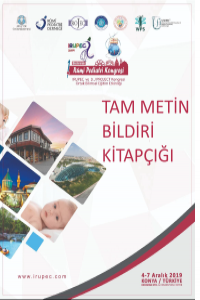Abstract
In our study, we evaluated infants who underwent ROP examination among infants born at 32 weeks or less and/or 1500 grams or less as well as infants who had more than these values but had a risky neonatal period. We used SAS University Edition 9.4 for statistical analysis. We divided the patients into two groups as those with and without ROP, and in those with ROP group, as requiring treatment and not-requiring treatment. We recorded the patients’ identity, maternal characteristics, antenatal/natal/postnatal features, and complications during follow-up, ROP control times, and complete blood count parameters (platelet count, MPV, platelet count/MPV). Primarily, we evaluated the differences of platelet parameters, especially the MPV values, between ROP requiring treatment and ROP not-requiring treatment groups and secondarily, we evaluated the correlation between scanned parameters and ROP development.
RESULTS:
ROP developed in 49 of 144 (34%) patients included in the study. ROP requiring treatment was detected as 51% of the ROP group (n: 25). The gestational age, birth weight, incidence of RDS, surfactant use and oxygen usage time, intraventricular hemorrhage, PDA, neonatal sepsis, erythrocyte transfusion number, NEC, BPD and time to catch birth weight were higher in patients with ROP than those without ROP. However, there was no significant difference in terms of MPV, platelet and platelet/MPV ratio.
Keywords
References
- References 1- Arikanoglu A, Yucel Y, Acar A, Cevik MU, Akil E, Varol S, Tasdemir N. The relationship of the mean platelet volume and C-reactive protein levels with mortality in ischemic stroke patients. Eur Rev Med Pharmacol Sci. 2013; 17(13): 1774-1777. 2- Cekmez F, Tanju IA, Canpolat FE, Aydinoz S, Aydemir G, Karademir F, Sarici SU. Mean platelet volume in very preterm infants: a predictor of morbidities. Eur Rev Med Pharmacol Sci. 2013; 17(1): 134-137. 3- Chu SG, Becker RC, Berger PB, Bhatt DL, Eikelboom JW, Konkle B, et al. Mean platelet volume as a predictor of cardiovascular risk: A systematic review and meta‐analysis. Journal of Thrombosis and Haemostasis. 2010; 8(1): 148-156. 4- Cil, H, Yavuz C, İslamoğlu Y, Tekbaş EÖ, Demirtaş S, Atılgan ZA, et al. Platelet count and mean platelet volume in patients with in-hospital deep venous thrombosis. Clinical and Applied Thrombosis/Hemostasis. 2012; 18(6): 650-653. 5- Kavurt S, Yücel H, Hekimoğlu E, Baş AY, Demirel N, Türkbay D. Prematüre retinopatisi gelişen olgularda risk faktörlerinin değerlendirilmesi. Çocuk Sağlığı ve Hastalıkları Dergisi, 2012; 55(3), 125-131. 6- Tao Y, Dong Y, Lu CW, Yang W, Li Q. Relationship between mean platelet volume and retinopathy of prematurity. Graefe's Archive for Clinical and Experimental Ophthalmology. 2015; 253(10): 1791-94. 7- Zengin N, Özer EA, Zengin MÖ, Türe G, Sütçüoğlu S, Talay E. Prematüre retinopatisi sıklığı ve risk faktörlerinin değerlendirilmesi. Cocuk Sagligi ve Hastaliklari Dergisi. 2014; 57(2).
Abstract
References
- References 1- Arikanoglu A, Yucel Y, Acar A, Cevik MU, Akil E, Varol S, Tasdemir N. The relationship of the mean platelet volume and C-reactive protein levels with mortality in ischemic stroke patients. Eur Rev Med Pharmacol Sci. 2013; 17(13): 1774-1777. 2- Cekmez F, Tanju IA, Canpolat FE, Aydinoz S, Aydemir G, Karademir F, Sarici SU. Mean platelet volume in very preterm infants: a predictor of morbidities. Eur Rev Med Pharmacol Sci. 2013; 17(1): 134-137. 3- Chu SG, Becker RC, Berger PB, Bhatt DL, Eikelboom JW, Konkle B, et al. Mean platelet volume as a predictor of cardiovascular risk: A systematic review and meta‐analysis. Journal of Thrombosis and Haemostasis. 2010; 8(1): 148-156. 4- Cil, H, Yavuz C, İslamoğlu Y, Tekbaş EÖ, Demirtaş S, Atılgan ZA, et al. Platelet count and mean platelet volume in patients with in-hospital deep venous thrombosis. Clinical and Applied Thrombosis/Hemostasis. 2012; 18(6): 650-653. 5- Kavurt S, Yücel H, Hekimoğlu E, Baş AY, Demirel N, Türkbay D. Prematüre retinopatisi gelişen olgularda risk faktörlerinin değerlendirilmesi. Çocuk Sağlığı ve Hastalıkları Dergisi, 2012; 55(3), 125-131. 6- Tao Y, Dong Y, Lu CW, Yang W, Li Q. Relationship between mean platelet volume and retinopathy of prematurity. Graefe's Archive for Clinical and Experimental Ophthalmology. 2015; 253(10): 1791-94. 7- Zengin N, Özer EA, Zengin MÖ, Türe G, Sütçüoğlu S, Talay E. Prematüre retinopatisi sıklığı ve risk faktörlerinin değerlendirilmesi. Cocuk Sagligi ve Hastaliklari Dergisi. 2014; 57(2).
Details
| Primary Language | English |
|---|---|
| Subjects | Health Care Administration |
| Journal Section | Congress Proceedings |
| Authors | |
| Publication Date | December 10, 2019 |
| Acceptance Date | January 16, 2020 |
| Published in Issue | Year 2019 Volume: 7 Issue: Ek - IRUPEC 2019 Kongresi Tam Metin Bildirileri |


